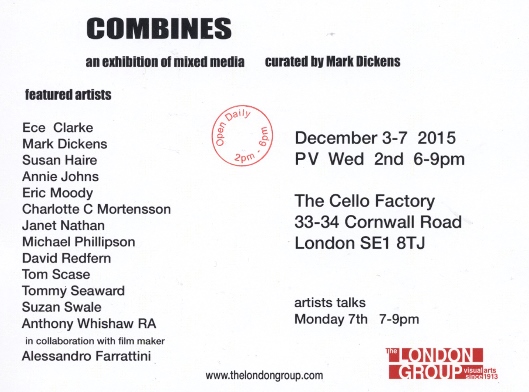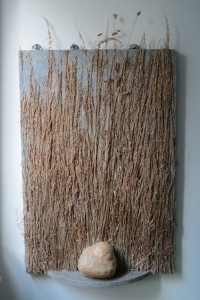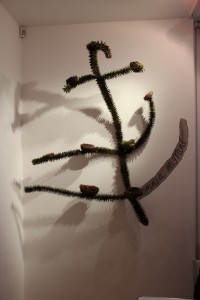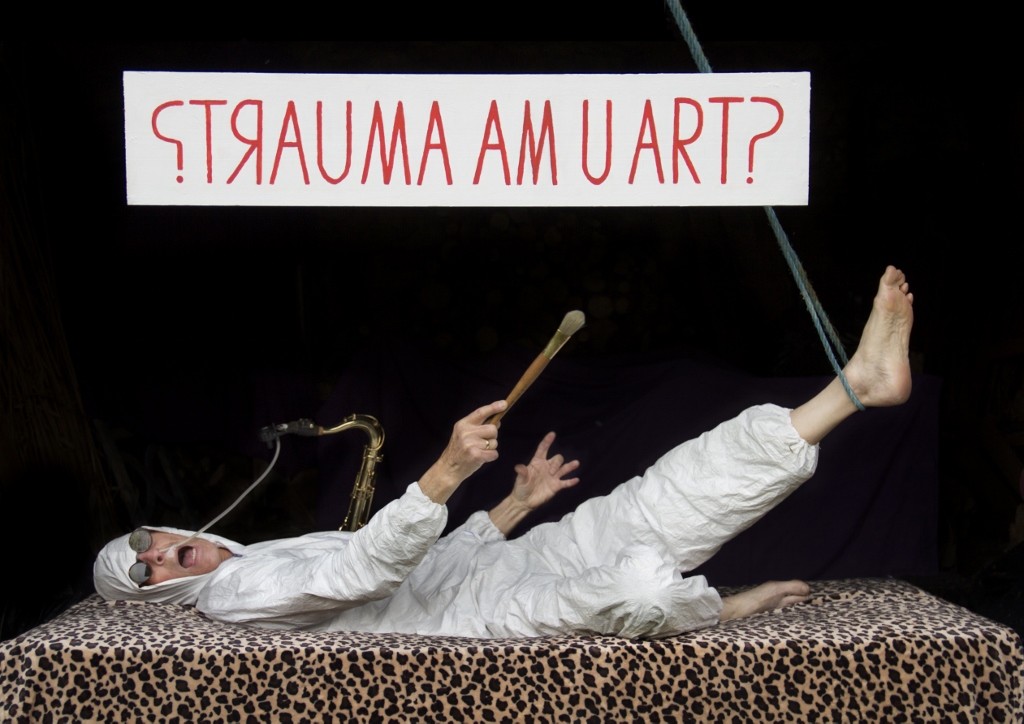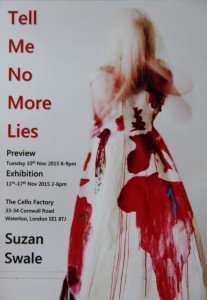
A fellow member of The London Group, the painter and multi-media artist Suzan Swale, has a retrospective under the title ‘Tell Me No More Lies’ at the Cello Factory, 33-34, Cornwall Road, London, SE1 8TJ, 11th-17th November, 2015, 2-6pm. The image on the show’s publicity card is of her installation ‘La Reine Margot’, (2012). I discuss aspects of her oeuvre in my essay – ‘Painting as Suspense’ – for the show’s catalogue. Here it is!
PAINTING AS SUSPENSE
She’s painting still…
Of course Suzan has drawn a miscellany of materials and processes (photographs, clothes, electric light, words, performance) into the play of her making. But painting is her home-zone, her source, resource, and point of perennial return. Throughout her oeuvre she deposits multiple clues to what drives her to live under painting’s demands. It is her love and feeling for painting’s still open celebratory possibilities that guide her responses to the other media and objects.
Take ‘Still Red’! Here the two words, set into and brought into play by the paint surrounding them, draw us into the tension that marks her creative trajectory. For, surely, she strives to survive as a painter by situating herself precisely in the gap between them: the ‘still’ and the ‘red’ – two seemingly simple words with multiple complex and ambiguous resonances.
To be painting ‘still’ is, on the one hand, to seek to commit oneself to explore ceaselessly, to live within, the movement – flow – that defines the substance and event of painting. On the other hand it is to recognise simultaneously that the destiny of one’s making-for-art is a perfectly still thing: the event of painting ends by painting itself into stillness. Each painting’s potent hope is to move us precisely by its very motionlessness. And ‘red’ enacts a similar tension that seems to be marking the ungraspable centre of Suzan’s journey through painting. For, as so many of her renderings of the human figure show, red is the real and symbolic marker of our red-dependency and -indebtedness: we are red-embodied flowings. And we spill this flow incessantly across diverse contexts. But the taken-for-granted cultural work of the word ‘red’ is also to act as the synonymous marker of an ethico-political vision. Still-red-painting situates its task within this tension. It is a tension whose poles – absolute tranquillity (stillness) and pure community (history’s after-life) – are precisely other to everything that now constitutes our everyday life. To seek to survive in between the ‘still’ and the ‘red’ – to keep on painting right there by combining them – is already to show the event of art-making as a leap toward otherness: art makes for that which is not-yet. This leap into otherness is precisely the difference that art strives to make; it is how it seeks to differentiate itself from all other sites of action. And Suzan’s idiosyncratic journeying ‘in between’ is marked by utterly distinctive concerns.
When, commenting on her own writing and echoing Virginia Woolf, the wonderful American writer Elizabeth Hardwick says that ‘Many things happen between the acts’ [1], she is gesturing, however obliquely, toward the gap where artists, irrespective of medium, seek to situate their making: they aim to site their activity in between the familiar outlines of recognisable acts. And of course each artist seeks to feel out, float in, and shape, their responses to this groundless gap in a distinctive way, a way that shows their knowing love for art’s living history. Relying absolutely on the strangeness of their own being-in-between, makers suspend the familiar boundaried and already meaningful acts of the theatre of everyday life precisely in order to broach their distinctive zone of unknowing. And what goes on ‘between the acts’ is, as Suzan’s paintings show us, invariably more elusive, troubling, and risky than hanging on in the relative comfort zones of commonsense.
In marking out the course of her own ‘in-between’ across a range of media Suzan draws us inexorably into the play of suspension. But, in suspending herself in making’s gap, Suzan soon began to reveal this very suspension as the recurrent focus of her ways through art. Specifically, it is our suspended embodiment that emerges as her defining motif and challenge. She sets herself the task of realising visually the unspeakable feelings engendered by our groundless suspension as we struggle to feel our way through the always conflicting demands of multiple social contexts, contexts where power is already at work in unseen ways.
Already in her earliest paintings (‘Wuthering Heights’, ‘The Invisible Backward Facing Grocer’, ‘The Woman in the Moon’) Suzan had begun to explore ways in which paint could halt the free-fall of groundlessness and show the fateful character of our suspension. Paint allows her to still the body-in-suspension and open onto its predicament. Specifically this is a body (and often bodies) suspended in a no-space or across several incommensurable conflicting spaces. But this suspension is differently nuanced as she moves across media and materials. As it recurs, the framed body is not just ‘any’ body. Always particularised and contextualised by each painting’s or object’s emergent spaces and demands, she offers embodiment, and especially woman’s embodiment, as perennially at risk: to be embodied is to live on while always at risk – at risk of damage, wounding, fragmentation, suffering… Yet this edgy living is always there to be celebrated and, in some part, hopefully redeemed by painting. Painting here takes on the body’s always unpredictable passage through risks, dangers and disasters, as its way of celebrating the body in whatever it undergoes: the suspended body-in-damage is rendered heroinic/heroic.
These suspended bodies, their fragments and accoutrements (words, instruments, clothes, and words, always words…), invariably caught up in and caught out by demands beyond their control, nevertheless remain there still. Interrupting and catching them in mid-act – embodiment as always under way, falling, standing, collapsing, lying right there – Suzan offers her painting project as a pledge to hang onto them somehow. She keeps them held up in the face of their immanent disappearance, fixes them strung out across the irreconcilable spaces (shown by her canvases’ striations, layerings, stripings) which catch us all out. By splitting open the all too routine and familiar acts in which bodies are subjected to disturbance, deterioration, and loss, she proceeds to give them a different life, a still life, on art’s terms.
Her figurings (they include, of course, animals, birds, clouds, scapes, flowers, the architectural and designed furnishings of the everyday, and much else), stitched into and across the canvases’ often striated surfaces, frequently confront or are caught up in the machined representations of global mass culture. Filmic and photographic imagery become both a resource and target that painting has to engage as it tries to hold on to its own possibility in the face of their simulated naturalisms. Suzan recognises that painting can take on the photograph and the film-strip clip. That is, it can both mime and undo – subvert and scatter – them. For her, this challenge is exemplified by the ways the Hollywood-holy-word-and-image-machine sets the terms against which everyday experience, perception, and meaning struggle to make their ways.
Under this Disneyfication of the world the integrated life of language and image is endlessly suborned by info-entertainment. As long as we are machinically informed and entertained without a break we are supposed to be OK. And, for Suzan, the archetypical figure for this process is Mickey M. (Minnie is significant by her absence in the paintings…) who pops up all over the place as a diminutive ‘everyman’ (or at least, given his short pants, everyboy). There he is, again and again, with his ears as ever turned rigidly forward so that he can hear (see?) only that which is right in front of him. And we are all familiar with this cartoon figure’s reassuring routinely miraculous escapes from whatever-threats; they seem to mark an extreme edge of cultural fantasies about the fate of (male…) embodiment. Mickey, the arch-mass communicator emergent post-man, becomes an exemplary double – the US male that bears the US mail’s prime message. Indeed, in the two ‘US Mail’ pieces Suzan offers this as an open and shut case. Mickey appears as motif for a repetitively patterned wallpaper that perhaps stands as the backcloth to all our everyday communicative acts, precisely the acts between which Suzan’s paintings aim to insert themselves on art’s and our behalf.
Delighting in the very matter of paint – its flowing manipulability and ability to transport us into her utterly distinctive elsewhere – Suzan faces us with the challenge of seeing anew through her bravura handling of this earthy stuff. Effecting a slit in the camouflaging fabric of the everyday, her paintings and objects invite us to pass from the commonsense of the without in order to feel out for ourselves an unspeakable within. The surfaces of her varied projects cajole us into tracing out for ourselves some of the ways the tremulous fragile body finds itself perennially at and as the living taut conjunction of always warring irreconcilable powers. At the least, Suzan’s oeuvre proposes, the leap away though art’s offerings may just move us to reconstitute for ourselves our dependence on such powers’ potency, to loosen however slightly the ligatures within which powers routinely bind us.
Michael Phillipson
February, 2015
[1][1] Elizabeth Hardwick, ‘Sleepless Nights’, Virago, London, 1980, p. 121. See also Virginia Woolf’s extraordinary final novel, ‘Between the Acts’, published after her death in 1941, Vintage, London, 2000.
